Physical Address
304 North Cardinal St.
Dorchester Center, MA 02124
The scalp is a common site for cutaneous malignancies and is frequently subjected to trauma. As such, the surgeon is often faced with complex scalp defects in need of repair. The scalp presents unique challenges to the reconstructive surgeon: it is thick and inelastic; it is hair-bearing; it covers a convex surface; and it provides the sole soft tissue covering for the cranium. In particular, the lack of elasticity of the scalp makes the repair of even small defects difficult. This chapter is intended to provide an overview of the relevant anatomy of the scalp and the techniques that are often used in its repair.
The anatomic layers of the scalp are well described by the convenient acronym “SCALP” ( Fig. 24.1 ). The “S” represents the Skin; the “C” the subCutaneous tissue; the “A” the galea Aponeurosis; the “L” the Loose connective tissue; and the “P” the Periosteum, also known as the pericranium . The scalp has the thickest skin on the body. Nevertheless, the scalp skin not only varies in thickness across the surface of the head but also may change throughout one’s life. The scalp skin is thickest when hair growth is at its most robust. If the hair thins, as in male-pattern baldness or pathologic alopecia, scalp thickness significantly decreases. The subcutaneous fat layer contains hair follicles and integumentary structures such as sweat and sebaceous glands. It provides a tight connection between the skin and the underlying galea. The galea is a dense, inelastic layer that provides a fibrous connection between the frontalis muscle anteriorly and the occipitalis muscle in the nape of the neck. Within and adjacent to the galea run numerous vascular and neural structures. In the forehead region, the galea envelops the frontalis muscle, which has no direct attachment to bone. Posteriorly, the galea encompasses the occipitalis, which inserts in the bone along the nuchal line. The periosteum is usually tightly affixed to the cranium and possesses its own vascular supply.
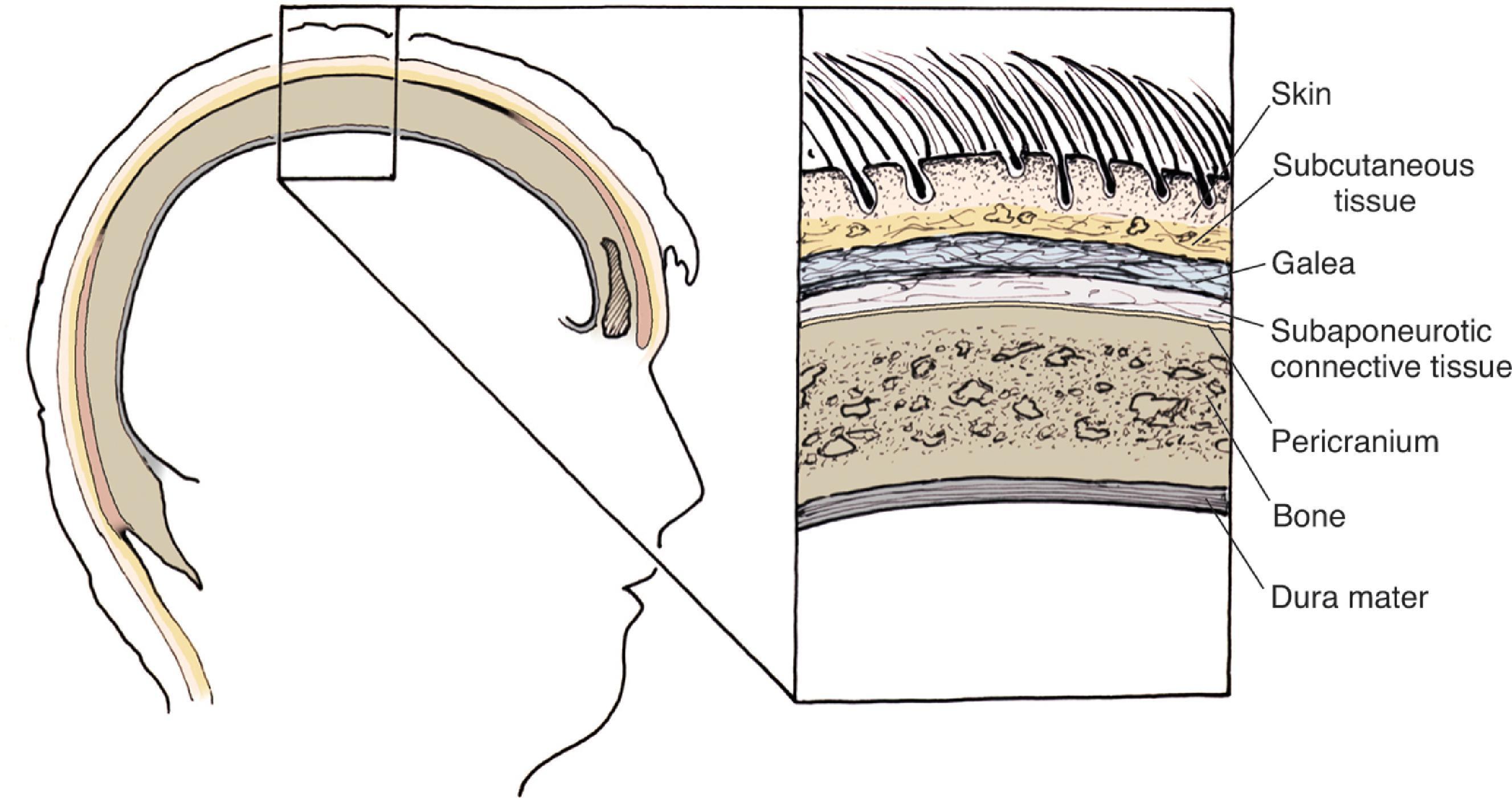
In the region of the temple, the anatomic layers of the scalp are more complex. Above the temporal line, which represents the superior aspect of the temporalis muscle, the “SCALP” acronym applies. Over the temporalis muscle, however, the layers of the scalp differ slightly from the remaining scalp ( Fig. 24.2 ). Over the superior aspect of the temporalis muscle, the first three layers of the scalp (the skin, subcutaneous fat, and galea) remain the same. Inferiorly, however, the galeal layer of the temporal region becomes the temporoparietal fascia. The temporoparietal fascia is loosely attached to the subcutaneous fat and is continuous with the fascia of the frontalis muscle in the forehead region. The temporoparietal fascia accounts for the difference between the loose and tight attachment of the scalp to the cranium ( Fig. 24.3 ). The tight region of the scalp has a dense galeal layer, no underlying muscle, and poor distensibility. In the loose regions of the scalp, the galea is thinner and overlies muscle anteriorly as well as posteriorly below the nuchal line and is considerably more distensible. It is important to understand this anatomic difference to be successful when planning scalp flaps. For example, small advancement and transposition flaps are effective for repairing medium-sized (3 cm) defects located in the loose regions of the scalp. Such flaps are not as effective for repairing similar sized defects located in the tight regions of the scalp because of the inelastic nature of the tissues in these areas.
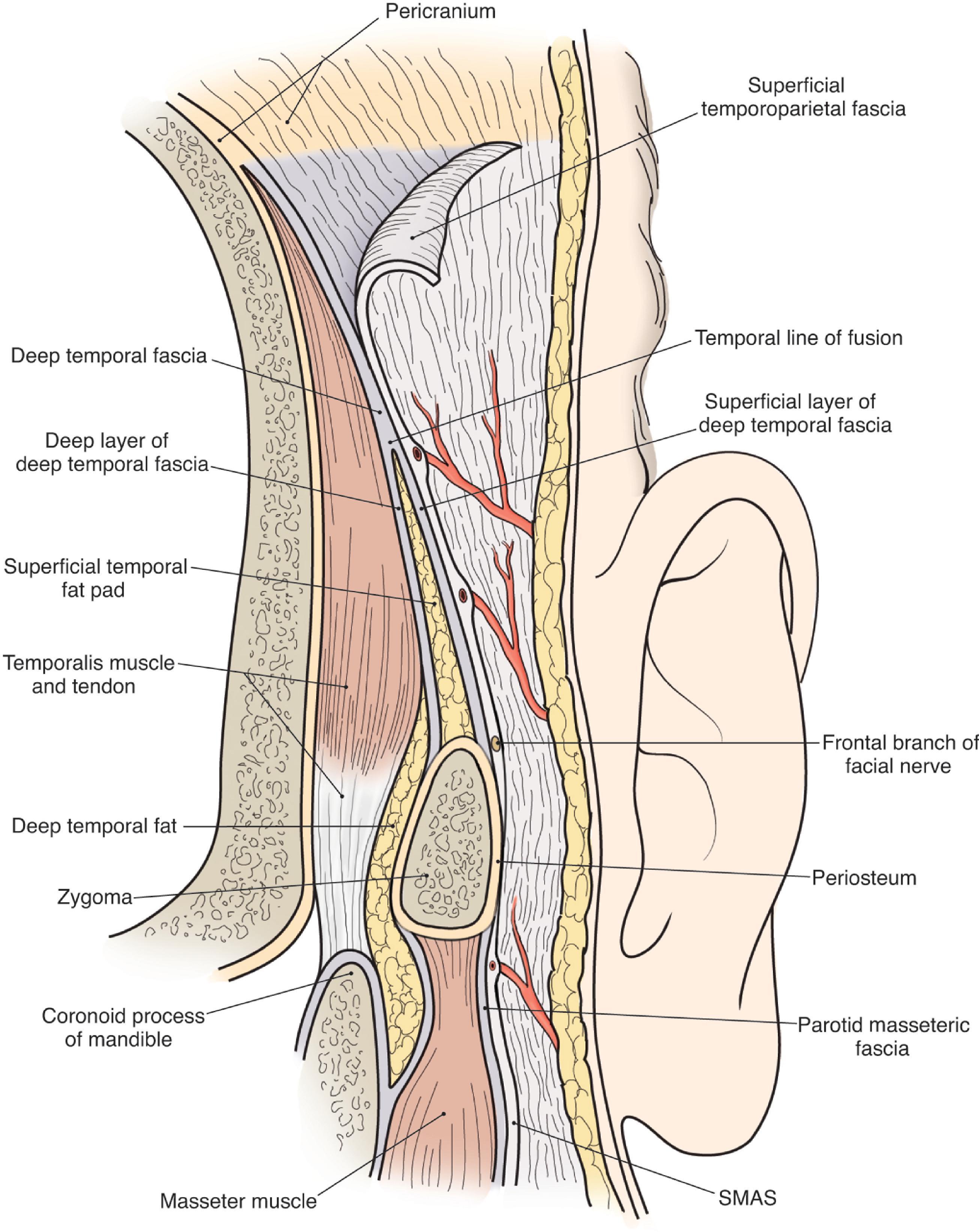
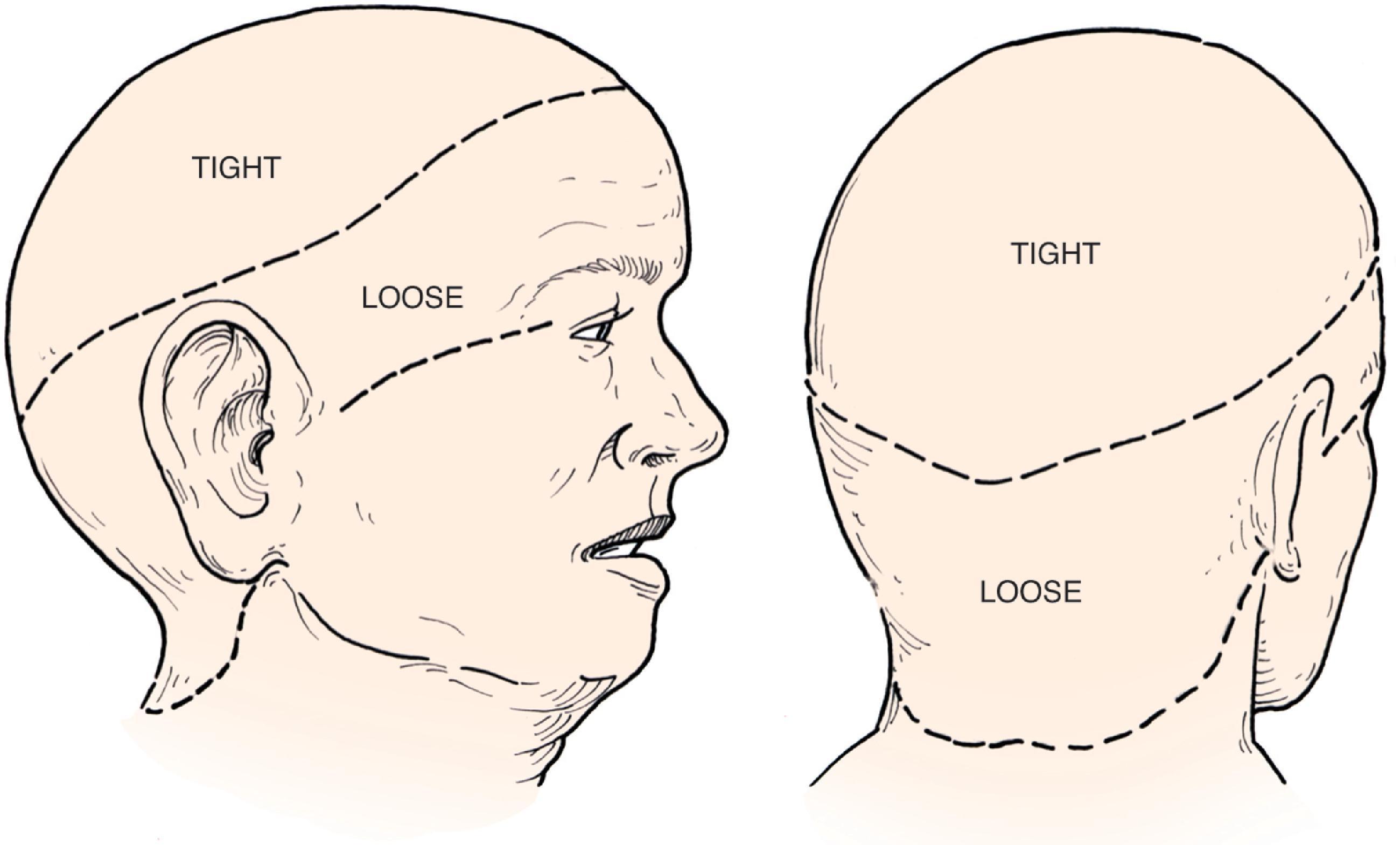
Within the temporoparietal fascia run the branches of the superficial temporal artery and the temporal branches of the facial nerve. A layer of loose connective tissue separates the temporoparietal fascia from the dense fascia of the temporalis muscle. Below the muscle is the periosteum of the temporal fossa. A few centimeters above the zygomatic arch, the fascia of the temporalis muscle splits to encase the temporal fat pad. At the level of the arch itself, the temporoparietal fascia, the superficial layer of the temporalis fascia, and the periosteum of the zygomatic arch all fuse into a single dense layer that is tightly attached to the arch. It is here that the temporal branch of the facial nerve is quite vulnerable to injury as it passes over the arch on its way to the frontalis and corrugator muscles of the forehead.
The scalp has a rich and redundant vascular supply ( Fig. 24.4 ). The external carotid artery provides the majority of the blood supply to the scalp via the superficial temporal, posterior auricular, and occipital arteries. The internal carotid system also supplies the scalp anteriorly through its terminal supraorbital and supratrochlear arteries, which course up the forehead after exiting the orbit. The robust vascular network of the scalp will usually support large random patterned local flaps with variable configurations; however, there are limited anastomotic connections across the midline. Thus flaps that extend a considerable distance across the midline may benefit from delay. This is particularly true in children. When designing flaps, the surgeon should be cognizant of the location and typical course of the principle arterial branches that supply the scalp and try to incorporate them in the base of the flap. A Doppler probe may be helpful in outlining the course of these vessels through the thick overlying skin. Many of the larger vascular branches run within the galea and temporoparietal fascia. To preserve these vessels, scalp flaps are ideally dissected just deep to this layer within the loose connective tissue creating a fasciocutaneous flap. The galea provides some protection to the vascularity of scalp flaps by limiting the elongation and crimping of vessels. The skin and subcutaneous tissue layers of the scalp also have a dense vascular plexus, but there is a greater risk for ischemia when flaps are dissected in the subcutaneous tissue plane. In addition, elevating a flap in the subcutaneous tissue plane subjects the hair follicles to the risk for injury and subsequent hair loss. The principle disadvantage of flaps that include the galeal layer is that the flaps are quite inelastic and nondistensible. Hence, scalp flaps must be designed with a large surface area relative to the size of the defect the flap is intended to repair. In addition, wound closure tension is likely to be higher compared with local cutaneous flaps used in other areas of the head and face.
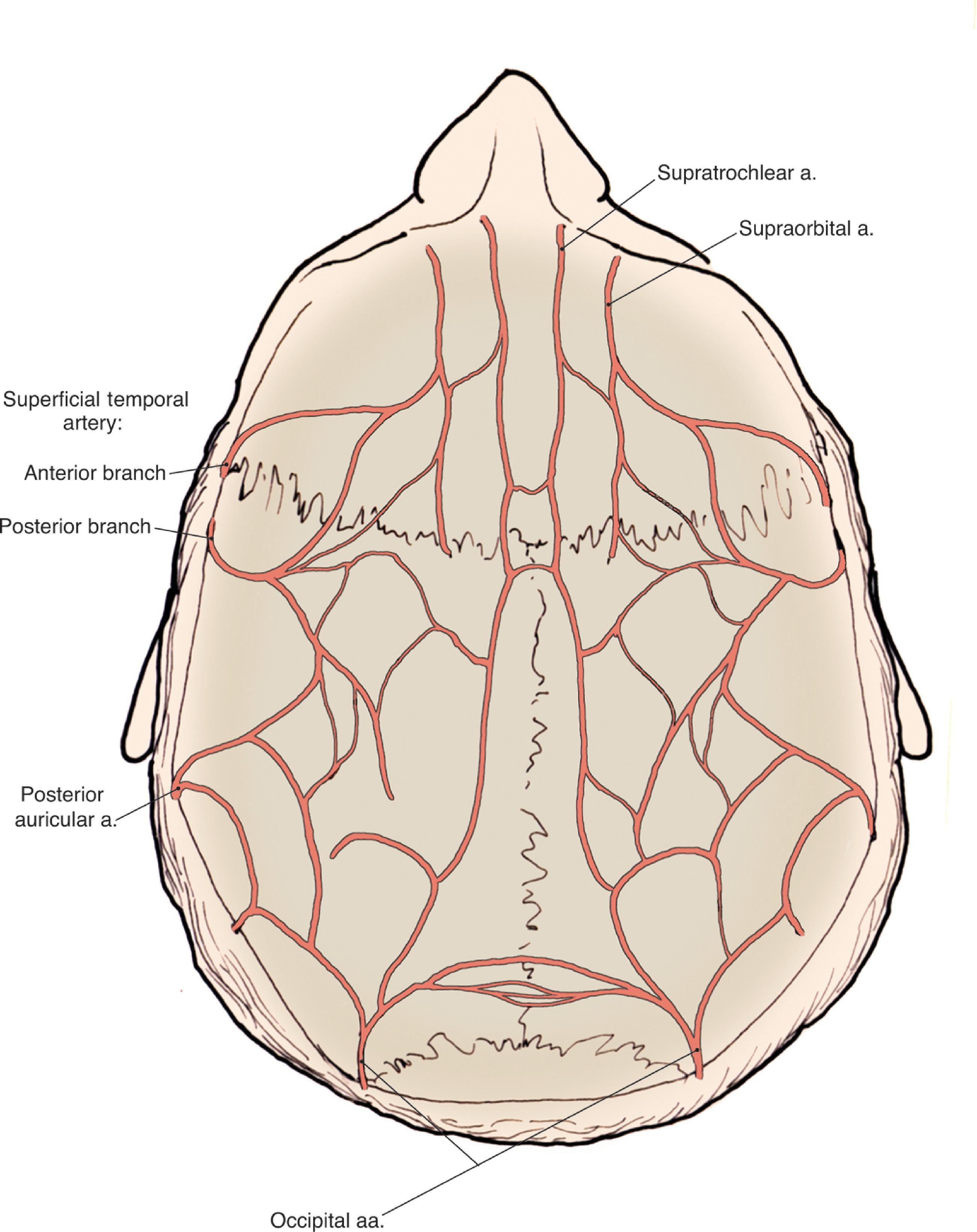
The lymphatic network of the scalp is quite extensive and lacks nodes, so flow is unimpeded. The scalp lymphatics drain into the parotid, anterior, and posterior auricular and occipital regions in roughly the same pattern as the venous drainage of the scalp.
The sensory innervation of the scalp is provided by multiple branches of the trigeminal nerve. The supraorbital nerve is the most easily identified nerve as it passes over the superior bony orbital rim through either a notch or foramen extending up the forehead and into the anterior scalp. The supratrochlear nerve provides sensation for the central forehead after it passes through the corrugator muscle. The lateral and posterior scalp is innervated by multiple branches of the temporal, auricular, and occipital sensory nerves. The only motor nerve of concern is the temporal branch of the facial nerve. As discussed previously, the nerve enters the temple region within the fascia over the zygomatic arch. It then runs within the galeal layer (temporoparietal fascia) until it innervates the frontalis and corrugator muscles on their deep surfaces. In most areas, if the surgical dissection is deep to the galea, the nerve is not at risk for injury. The exception is in the vicinity of the zygomatic arch where the dissection plane should be beneath the superficial layer of the temporalis fascia and periosteum of the arch. In this way, the temporal branch of the facial nerve will remain superficial to the plane of dissection and within the flap itself. For most cutaneous defects located in the areas of the temple and zygomatic arch, however, dissection should be in the subcutaneous tissue plane and hence superficial to the branches of the nerve. It is essential that the surgeon become very familiar with the anatomy of the scalp and forehead skin in the region of the temple before embarking on the transfer of local flaps or other surgical procedures in this region of the face.
The layers of the scalp provide convenient surgical dissection planes. Dissection beneath the galeal layer is simple, swift, and relatively avascular. Large flaps can be readily dissected in this tissue plane with minimal effort and good reliability. Flaps dissected in the subcutaneous plane compared with subgaleal dissection are considerably more difficult because this is a “nonanatomic” plane that requires sharp surgical dissection. Typically, these types of flaps are elevated just below the hair follicles within the subcutaneous fat. Numerous small vessels are encountered, and hemostasis can be difficult. In addition, electrocautery used to secure hemostasis can injure the hair follicles. For these reasons, scalp flaps consisting only of skin and subcutaneous fat are rarely employed. In the area over the temporalis muscle, the temporoparietal fascia can be raised as an independent flap on a pedicle or as a microsurgical free flap and transferred to an adjacent or distant site. , Incisions for the flap must remain posterior to the course of the temporal branch of the facial nerve to avoid denervation of the frontalis and corrugator muscles. The temporoparietal fascia flap is quite useful in auricular and orbital reconstruction because it provides thin, supple, and highly vascular tissue supplied by the posterior branch of the superficial temporal artery. , Details of this flap are discussed elsewhere in this chapter. Flaps consisting of periosteum can also be developed independent of the overlying scalp tissues.
The primary goal of scalp reconstruction is to provide a viable and durable covering for the cranium. Secondary goals are to maintain the hairline and contour of the scalp. The need to restore hair-bearing scalp creates unique challenges and greatly limits the surgeon’s options. If a scalp defect is full-thickness, including the pericranium, then a scalp flap is the preferred method of repair ( Fig. 24.5 ). The thick and inelastic nature of the scalp is advantageous because of its ample vascular supply and disadvantageous because of the inelasticity of the tissue. By necessity, scalp flaps are designed relatively large compared with the defect size, yet they are usually quite robust and can tolerate more wound closure tension than flaps elsewhere on the face. Tissue expansion can be quite helpful as an adjunct procedure but requires a stable wound and as such is rarely applicable to the repair of a fresh wound created by trauma or by an oncologic resection.
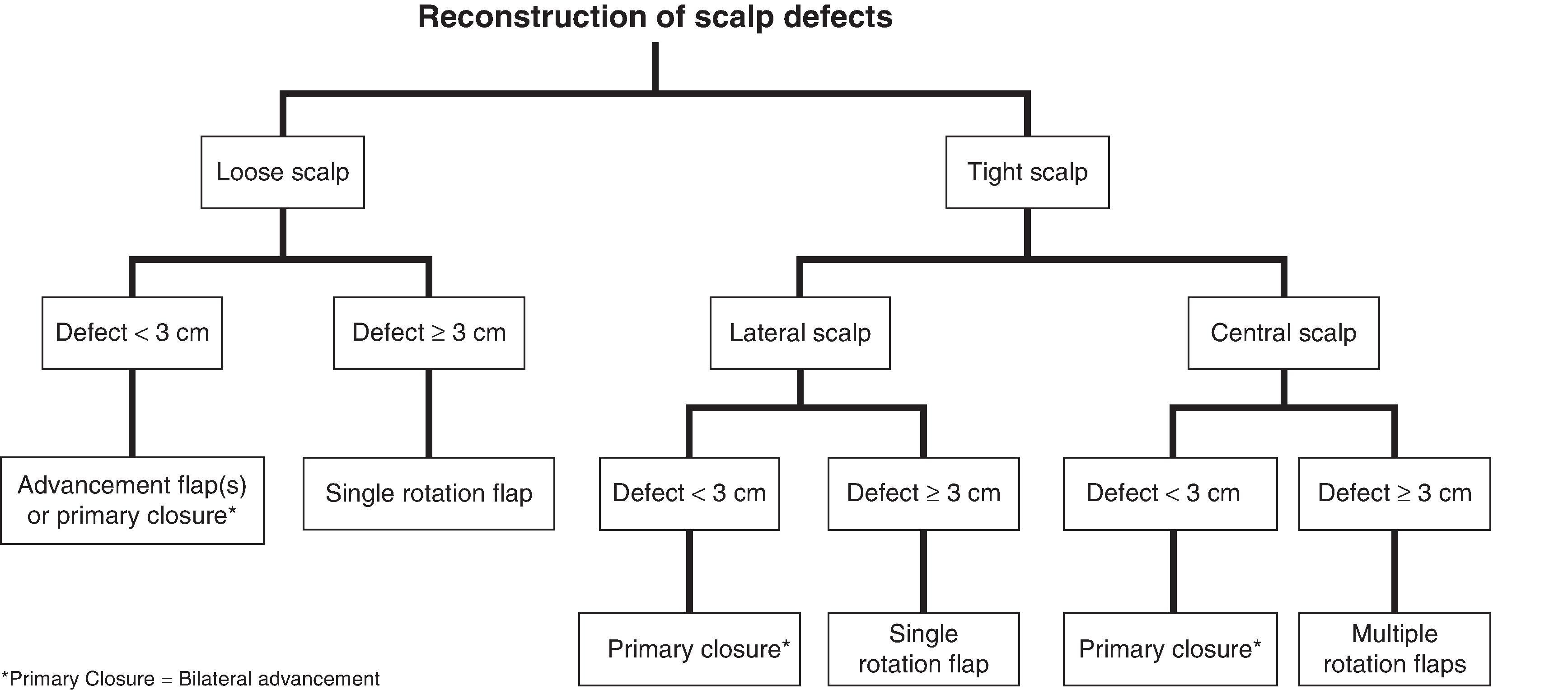
In some instances, allowing a scalp defect to heal by secondary intention may be a good option. Several criteria should be met, however, before selecting this option for the treatment of defects of the scalp. Most importantly, there must be a base of viable tissue such as pericranium on which granulation tissue can form. Occasionally, bare bone may support the formation of granulation tissue on its own, but the process is exceedingly slow and fraught with problems. The surgeon can enhance the formation of granulation tissue by removing the outer table of the cranium to the level of the diploic space, which is quite vascular. This may allow for islands of granulation to form, which will then coalesce into a continuous layer that can support re-epithelialization of the wound or a skin graft.
There are several drawbacks to allowing scalp defects to heal by secondary intention. Unlike wounds elsewhere on the head and neck, scalp wounds will minimally contract because of the stiff galea. Thus it may take many weeks for a wound to heal. Wound care can be laborious and tedious for the patient or their caregiver. When healing has occurred, the area will be devoid of hair and the regenerated skin covering the area will be significantly thinner than the skin of the surrounding scalp. The thin skin has a propensity to break down into an open wound from minimal trauma to the area. In areas that have previously been irradiated or otherwise traumatized, the healing may be incomplete or extremely slow. Nonetheless, in selected patients and in certain areas such as the vertex in a bald patient, the result of a wound healing by secondary intention can be acceptable ( Fig. 24.6 ). This is particularly true if scalp defects are partial thickness, involving only the skin and not deeper tissues.
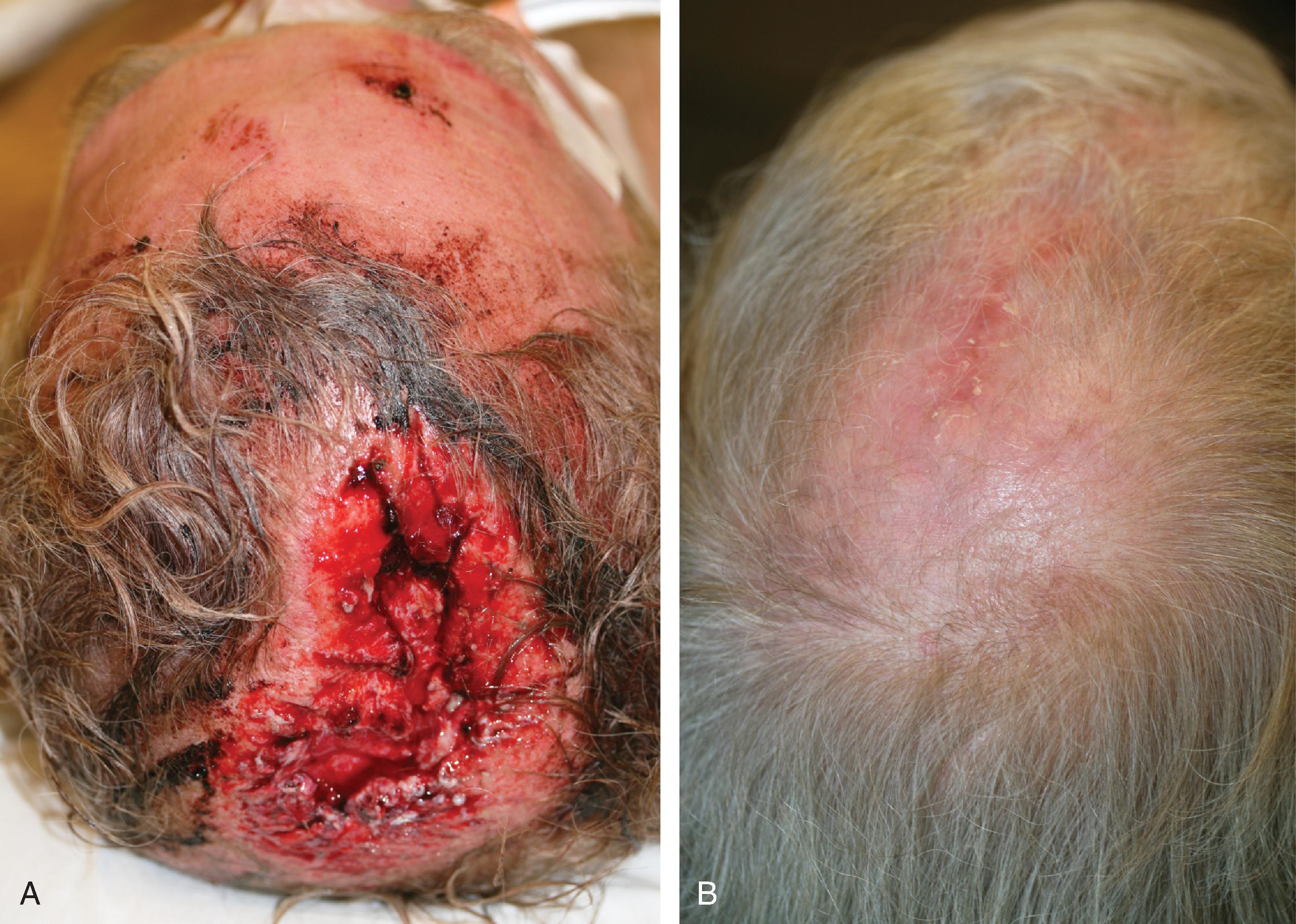
In general, defects of the scalp up to 3 cm in diameter may be repaired with primary wound closure. To accomplish this, however, very wide undermining of the scalp in the subgaleal plane is required. This can often be accomplished by blunt dissection using finger dissection. Galeal relaxing incisions may also be judiciously employed on the undersurface of the scalp to allow some stretching of the galea, thereby reducing wound closure tension ( Fig. 24.7 ). This technique can also be used when transferring scalp flaps. Galeal relaxing incisions must be performed cautiously to avoid damaging the vascular structures that are immediately superficial to the galea. Some authors have advocated intraoperative tissue expansion to assist flap elevation and to facilitate closing scalp wounds. , This technique is discussed in more detail later in this chapter. Other tissue stretching devices have been employed as an adjunct to facilitate primary wound repair. Once the scalp is sufficiently undermined, the wound edges are advanced and apposed in layered fashion. The galeal layer should bear the majority of the closure tension to minimize the tension on the skin closure line. Wound closure tension placed on the galea and not the skin of the scalp avoids trauma to hair follicles and reduces the risk for postoperative alopecia. It is common for standing cutaneous deformities (SCDs) to form at the borders of the defect because of the inelastic nature of scalp. Nevertheless, most of these will gradually resolve over time and rarely require secondary revision.
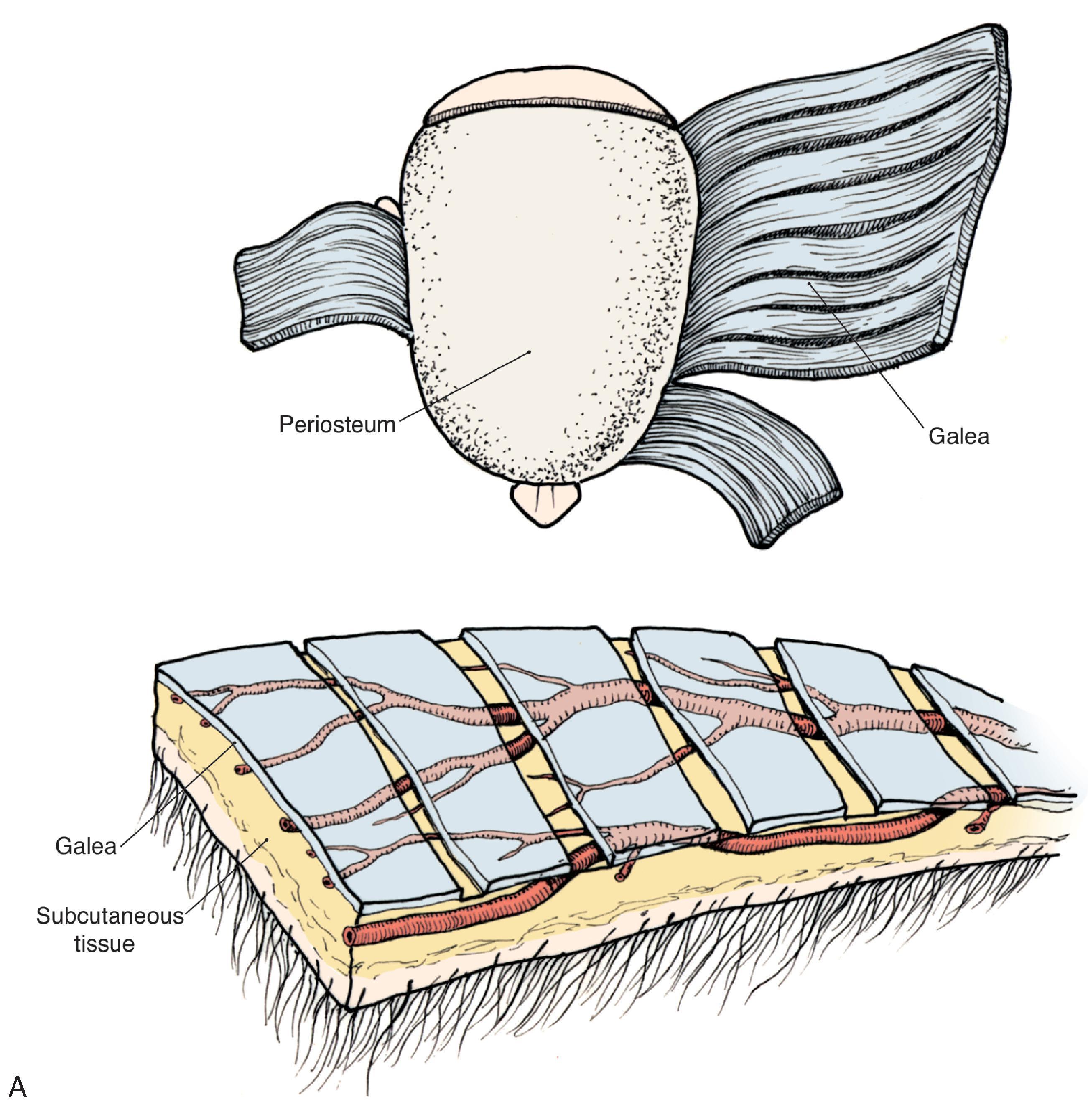
Become a Clinical Tree membership for Full access and enjoy Unlimited articles
If you are a member. Log in here